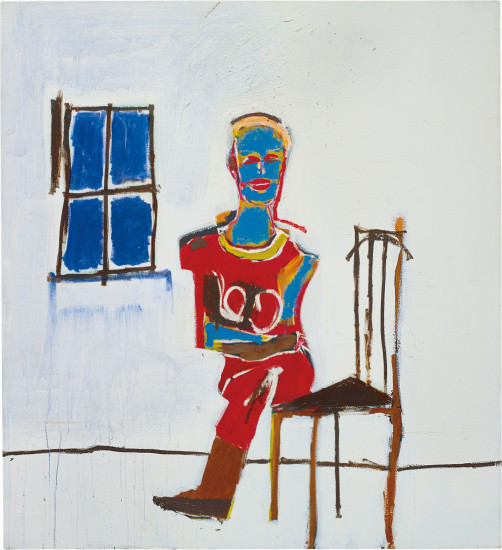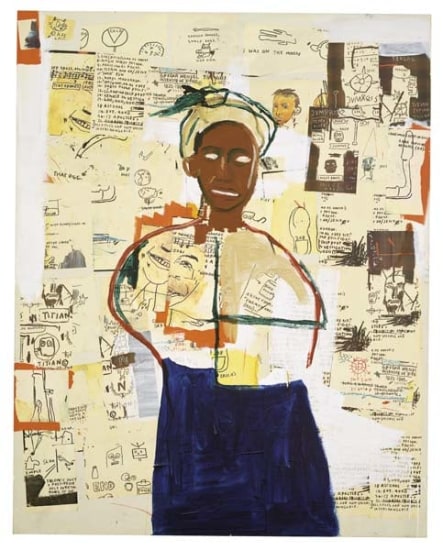Jean-Michel-Basquiat Untitled Head 1982 India ink and crayon on paper 19 x 24 in. (48.3 x 61 cm)
Provenance Larry Gagosian Gallery, Los Angeles Acquired from the above by the present owner, circa 1982-1983 Catalogue Essay “Believe it or not, I can actually draw.” –Jean-Michel Basquiat Executed at the pinnacle of the young artist’s career, Jean-Michel-Basquiat’s Untitled work on paper from 1982 embodies the expressiveness of painting from decades before him, combined with the former street artist’s graffiti-like aesthetic in a single sheet. The result is a foreboding, floating head composed of black acrylic, India ink and crayon. Its only distinguishing features are built from negative spaces—set into the image is a set of bulging eyes, each outlined by the pure black surrounding them. Unique in its monochromatic nature and consistent in its subject matter, the drawing stands out in the artist’s short, yet prolific oeuvre of paintings and drawings, completed in the year that the artist first rose to fame in the 1980s art scene. Basquiat’s thick and gestural application of the mixed media in this work emphasizes the artist’s regard for drawing as a medium in its own right, commanding the presence of a large-scale painting. As Robert Storr notes, "drawing, for him, was something you did rather than something done, an activity rather than a medium" (Dieter Buchhart, Basquiat, exh. cat., Fondation Beyler, Basel, 2010, p. 10). The resulting composition is active indeed, borrowing the dynamic energy of Basquiat’s graphic graffiti as the street artist SAMO. In its expressivity, however, his practice simultaneously recalls the emotional quality of paintings by artists like Pablo Picasso Willem de Kooning and Franz Kline particularly in the present lot’s all black marks. While identifiable as a human skull, the drawing retains a sense of the abstract through the artist’s use of materials. As curator Marc Mayer describes, Basquiat works in the same vein as one of “a seasoned abstractionist, but in the service of a figurative and narrative agenda” (Marc Mayer, "Basquiat in History," Basquiat, exh. cat., Brooklyn Museum of Art, Brooklyn, 2005, p. 46). The present lot draws upon other less sophisticated influences as well, all of which have been consistently discussed and debated by the art community to which Basquiat belonged. Born in Brooklyn in 1960 to a mother of Afro-Puerto Rican descent and a Haitian father, the artist was identified by many as simply a “black artist.” Further categorization of his aesthetic resulted in overly simplistic labels of "primitive” and “African.” While far too restricting, such terms do rightfully assert an aesthetic connection between Basquiat’s quickened drawings of human heads and African tribal masks, as is evident in Untitled, where the duality of black crayon and white paper creates the exact sort of cavities found in such objects. Even still, critics of the late 20th-century unfairly limited the scope of the artist and ignored the hybridity of his style. In the interview script from 1988 conducted by Demosthenes Davvetas, these restrictions are confirmed through the interviewer’s repeated use of phrases such as “graffiti artist,” “primitive signs,” “African roots,” and “cult.” By simplifying his art, Davvetas and many others believed that Basquiat’s success was derived not from his artistic ability, but instead from his ability to attract attention. Throughout his rise to fame, the artist attracted the attention of and established relationships with many important dealers and gallerists. In April 1982 when the artist completed this work, he traveled to Larry Gagosian’s Los Angeles gallery for a show, organized by Gagosian and Basquiat’s first gallerist, Annina Nosei. Negative attention surrounded the artist when he persuaded Gagosian to fly out several members of his entourage, as Gagosian recalled, “I bought first-class tickets for Jean-Michel- Rammellzee, Toxic, A-1, and Fab 5 Freddy. Annina was furious because she thought I was really spoiling them. But I thought it would be fun. And maybe
Jean-Michel-Basquiat Untitled Head 1982 India ink and crayon on paper 19 x 24 in. (48.3 x 61 cm)
Provenance Larry Gagosian Gallery, Los Angeles Acquired from the above by the present owner, circa 1982-1983 Catalogue Essay “Believe it or not, I can actually draw.” –Jean-Michel Basquiat Executed at the pinnacle of the young artist’s career, Jean-Michel-Basquiat’s Untitled work on paper from 1982 embodies the expressiveness of painting from decades before him, combined with the former street artist’s graffiti-like aesthetic in a single sheet. The result is a foreboding, floating head composed of black acrylic, India ink and crayon. Its only distinguishing features are built from negative spaces—set into the image is a set of bulging eyes, each outlined by the pure black surrounding them. Unique in its monochromatic nature and consistent in its subject matter, the drawing stands out in the artist’s short, yet prolific oeuvre of paintings and drawings, completed in the year that the artist first rose to fame in the 1980s art scene. Basquiat’s thick and gestural application of the mixed media in this work emphasizes the artist’s regard for drawing as a medium in its own right, commanding the presence of a large-scale painting. As Robert Storr notes, "drawing, for him, was something you did rather than something done, an activity rather than a medium" (Dieter Buchhart, Basquiat, exh. cat., Fondation Beyler, Basel, 2010, p. 10). The resulting composition is active indeed, borrowing the dynamic energy of Basquiat’s graphic graffiti as the street artist SAMO. In its expressivity, however, his practice simultaneously recalls the emotional quality of paintings by artists like Pablo Picasso Willem de Kooning and Franz Kline particularly in the present lot’s all black marks. While identifiable as a human skull, the drawing retains a sense of the abstract through the artist’s use of materials. As curator Marc Mayer describes, Basquiat works in the same vein as one of “a seasoned abstractionist, but in the service of a figurative and narrative agenda” (Marc Mayer, "Basquiat in History," Basquiat, exh. cat., Brooklyn Museum of Art, Brooklyn, 2005, p. 46). The present lot draws upon other less sophisticated influences as well, all of which have been consistently discussed and debated by the art community to which Basquiat belonged. Born in Brooklyn in 1960 to a mother of Afro-Puerto Rican descent and a Haitian father, the artist was identified by many as simply a “black artist.” Further categorization of his aesthetic resulted in overly simplistic labels of "primitive” and “African.” While far too restricting, such terms do rightfully assert an aesthetic connection between Basquiat’s quickened drawings of human heads and African tribal masks, as is evident in Untitled, where the duality of black crayon and white paper creates the exact sort of cavities found in such objects. Even still, critics of the late 20th-century unfairly limited the scope of the artist and ignored the hybridity of his style. In the interview script from 1988 conducted by Demosthenes Davvetas, these restrictions are confirmed through the interviewer’s repeated use of phrases such as “graffiti artist,” “primitive signs,” “African roots,” and “cult.” By simplifying his art, Davvetas and many others believed that Basquiat’s success was derived not from his artistic ability, but instead from his ability to attract attention. Throughout his rise to fame, the artist attracted the attention of and established relationships with many important dealers and gallerists. In April 1982 when the artist completed this work, he traveled to Larry Gagosian’s Los Angeles gallery for a show, organized by Gagosian and Basquiat’s first gallerist, Annina Nosei. Negative attention surrounded the artist when he persuaded Gagosian to fly out several members of his entourage, as Gagosian recalled, “I bought first-class tickets for Jean-Michel- Rammellzee, Toxic, A-1, and Fab 5 Freddy. Annina was furious because she thought I was really spoiling them. But I thought it would be fun. And maybe

.jpg)









Testen Sie LotSearch und seine Premium-Features 7 Tage - ohne Kosten!
Lassen Sie sich automatisch über neue Objekte in kommenden Auktionen benachrichtigen.
Suchauftrag anlegen